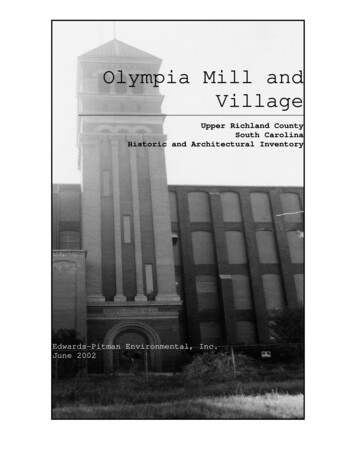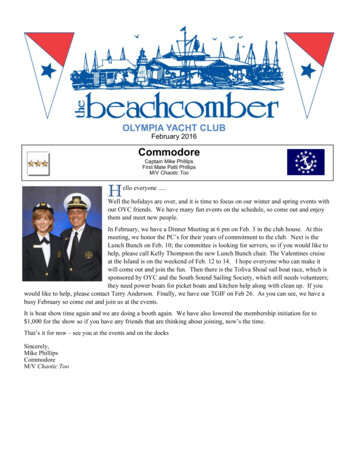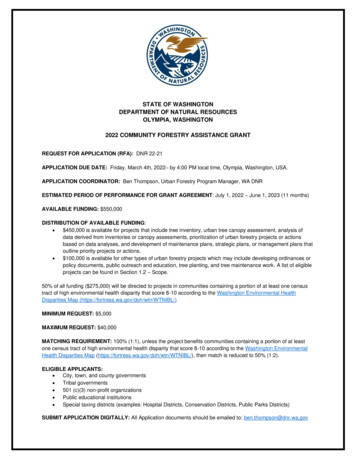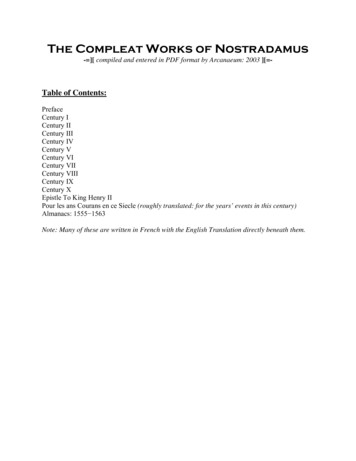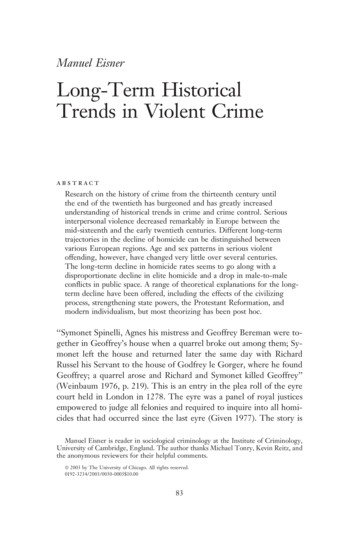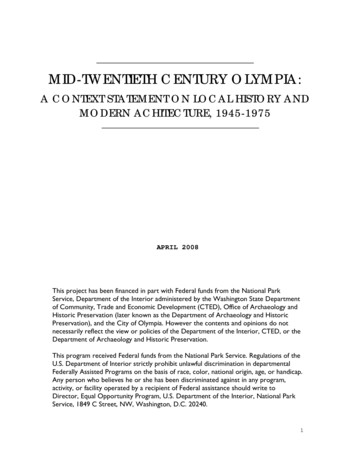
Transcription
MID-TWENTIETH CENTURY OLYMPIA:A CONTEXT STATEMENT ON LOCAL HISTORY ANDMODERN ACHITECTURE, 1945-1975APRIL 2008This project has been financed in part with Federal funds from the National ParkService, Department of the Interior administered by the Washington State Departmentof Community, Trade and Economic Development (CTED), Office of Archaeology andHistoric Preservation (later known as the Department of Archaeology and HistoricPreservation), and the City of Olympia. However the contents and opinions do notnecessarily reflect the view or policies of the Department of the Interior, CTED, or theDepartment of Archaeology and Historic Preservation.This program received Federal funds from the National Park Service. Regulations of theU.S. Department of Interior strictly prohibit unlawful discrimination in departmentalFederally Assisted Programs on the basis of race, color, national origin, age, or handicap.Any person who believes he or she has been discriminated against in any program,activity, or facility operated by a recipient of Federal assistance should write toDirector, Equal Opportunity Program, U.S. Department of the Interior, National ParkService, 1849 C Street, NW, Washington, D.C. 20240.1
NOTE TO READERDear Reader,It may be of some surprise that buildings designed and constructed during one’s lifetimecould be of historic significance. This context statement is intended to provideinformation useful in illuminating and preserving the historic resources of the recentpast. The mid-twentieth century was a dynamic period for Olympia, bringing substantialchanges to Olympia’s population and to its natural and built environment.By acknowledging the importance of the recent past, we challenge the notion that thebuilt environment can be frozen at any point in time. Just as Olympia can never remainexactly as it was at a single point in history, the work of preservation is never done. Wemust continually be aware of the passage of time and respond to Olympia’s evolvinghistory and changes to the community.This document provides an opportunity for the City of Olympia to reflect on its recenthistoric resources as it moves towards a bright future. We should be asking ourselvesfundamental questions about the recent past: What are the stories that futuregenerations must understand from the post-World War II era? What resources can andshould be preserved? Are there opportunities to reuse buildings as we strive towardssustainability, finding ways to meet today’s needs while saving resources from our past?This context statement is the culmination of the effort of the members of the HeritageCommission, the Modern Architecture Committee of the Heritage Commission (LoisFenske, Brian Sopke, Dwayne Harkness, Spencer Daniels, Heidi Williams, Diane Wiatr,and myself), former and present staff of the Commission, and other volunteers. Specialthanks to Shanna Stevenson for her in-depth research and completing the initial drafts ofthis statement. Thanks to the Department of Archaeology and Historic Preservation forassistance and advice, especially the groundbreaking work and assistance of the StateArchitectural Historian Michael Houser. Thanks to those who agreed to be interviewedto provide more information about their contributions to local history during thisperiod. Thanks to Lanny Weaver and others at the Southwest Regional Archives of theState of Washington and the reference librarians of the Washington State Library.Finally, thanks to everyone who has taken part in shaping Olympia’s fascinating history.Jennifer Minner, Chair (February 2006 – February 2008)City of Olympia Heritage Commission2
TABLE OF CONTENTSNOTE TO READER 2HOW TO USE THIS CONTEXT STATEMENT 4SOCIAL CHANGE AND CULTURAL DIVERSITY 5RESIDENTIAL DEVELOPMENT 9COMMERCIAL DEVELOPMENT 13INDUSTRY AND MANUFACTURING 22AGRICULTURE AND RELATED INDUSTRIES 28TRANSPORTATION 31COMMUNICATION 36GOVERNMENT 40EDUCATION – K through 12 45HIGHER EDUCATION 48RECREATION AND SOCIETY 52HEALTH AND MEDICINE 58RELIGION AND FUNERARY 60ARCHITECTURAL STYLES AND BUILDING FORMS OF THE MODERN ERA 66OLYMPIA ARCHITECTS OF THE MODERN ERA 88APPENDIX A: DETAILED POPULATION DEMOGRAPHICS 92SOURCES OF INFORMATION 943
HOW TO USE THIS CONTEXT STATEMENTThis context statement is intended to inform historic preservation and planning in theCity of Olympia. It is also meant as a resource for anyone who is interested in learningabout Olympia’s history during the post-World War II period. The context statementdescribes broad patterns of historical information including themes, events, andindividuals. It also provides the background by which a specific occurrence, building, orsite is understood, and its meaning within history is established. The context statementis an evolving document, which allows for amendment as more information becomesavailable. The three elements used to develop a historic context are theme, time andplace.ThemeThis is a geographically based study of the City of Olympia within its current boundarieswith the sub-themes, such as Transportation, Communication, Government, ResidentialDevelopment, Commercial Development, Industry and Manufacturing, Education, andReligion and Funerary among others.TimeThe time period is from 1945 to 1975. Earlier context studies for Olympia includeResidential Architecture in Olympia, Women's History in Olympia, and Historic Resources ofOlympia MPD. This study provides for supplementary information about Olympia historybringing it to within 30 years before the present time. This will allow the document tobe usable for several years to come in historic preservation efforts such as evaluatinghistoric properties as they become 50 years old.PlacePlace is the geographical boundaries of the context statement. While the city limits andgeographic features of Olympia have changed through time, the boundaries used in thiscontext statement are the 2007 city limits of Olympia.The context statement is organized by theme and then towards the end of thestatement is information about the identification of common building forms andarchitectural styles during the modern period. Architectural styles are referencedthroughout the document, and this section provides more detail about the features ofeach style and their origin.4
SOCIAL CHANGE AND CULTURAL DIVERSITYAfter World War II, Olympia’s population continued to grow through births, inmigration, and annexation. Between 1940 and 1970, Olympia's population increasedfrom 13,254 to 23,296.i The chart below shows the population of Olympia and ThurstonCounty for each decade from 1900 to 2000. The chart shows a steady increase inOlympia’s population during the modern era.Population of Olympia and Thurston County, 1900-2000250,000Period ofcontextstatement200,000Thurston County150,000Olympia, Thurston100,00050,00001900 1910 1920 1930 1940 1950 1960 1970 1980 1990 2000Source of data: State of Washington Office of FinancialIn Thurston County, the reasons for population growth shifted over time. From 1950 to1960, almost 70% of the population growth in Thurston County could be attributed tonatural increase (births) and just over 30% is attributed to the migration of people intothe county. Between 1960 and 1970, nearly 70% of the county’s population increasecould be attributed to migration.iiPopulation growth was to bring greater cultural diversity; however, even by 1970, over98.5% of Thurston County’s population was White.iii The table below shows a simplifiedversion of U.S. Census Bureau data, while the tables in Appendix A show more detailedinformation. These more detailed tables are interesting, not only for understandingchanges to the racial composition of Olympia’s population, but also for the shiftingcategories used to describe population demographics.City of Olympia Racial Composition (1940-1980)19401950Percent White*99.5%99.8%Percent .4%6.6%*Includes Native and Foreign-born** All other racial categories5
Since the mid-century modern period, the population ofOlympia, and that of Thurston County as a whole, hasbecome more diverse. Although the minoritypopulation in Olympia was relatively small during themodern era, cultural diversity is an important part ofOlympia’s history.World War II and Japanese InternmentIn 1942, the City of Olympia was included as a portionof “Military Area #1,” a portion of the West Coastaffected by Executive Order 9066, which authorizedmilitary commanders to exclude any person from anyarea. “Enemy aliens” and all Japanese, regardless ofcitizenship, were subject to removal from the area.Individuals and families were forced from their homes.Many were temporarily housed at the PuyallupFairgrounds, where they lived in animal stalls and wereguarded by military personnel. In September of 1945,the Japanese surrendered, and the camp residents werereleased, often with no money, jobs or homes. Aftertheir release and relocation, many Japanese Olympiansworked in the oyster trade. The Oyster House atPercival Landing was originally an oyster-openingwarehouse that employed many Japanese workers.John Gayton and theOlympia Brewing CompanyJohn Gayton was recruitedin 1958 to be the firstAfrican American to workfor Olympia BrewingCompany as a CompanyRepresentative. Accordingto an article about him:“Not only a first for theindustry in theNorthwest, but for anymajor corporation in theNorthwest. He went on tobecome the West Coastrepresentative andcoordinator of theAfrican-American market,as such responsible forhelping Olympia’s firstadvertising, media,promotional, sales, andcommunity outreachprograms directed at theAfrican-American market.”– Quote from John C.Gayton, from HistoryLink.org article “Gayton,John Cyrus (1931-2005),African American Leader.”The Loss of Olympia’s ChinatownPrior to the modern period, Olympia was home tomany Chinese immigrants. Due to restrictions onimmigration, the Chinese population decreasedsignificantly. Olympia’s Chinatown buildings were razedin 1943. Chinese business owners continued to dobusiness in the Olympia downtown area. Suey KayLocke emigrated around 1900, and brought his wife, Lam Shee, and their first twochildren to Olympia in 1915. Lam Shee Kay, with the help of their children, openedKay’s Cafe on Capitol Way in 1941, which continued operation through 1976.Native Americans and Fishing RightsIn the 1960s, both at the Capitol grounds and at Capitol Lake in Olympia, the case forIndian fishing rights was advocated through demonstrations and sit-ins by tribalmembers from the Medicine Creek Treaty Tribes and those opposed to fishing rights.Billy Frank and his sister, Maisell Bridges, both Nisqually tribal members, were joined bycelebrities such as Marlon Brando and Dick Gregory in solidarity. The federal BoldtDecision in 1974 reinstated Indian fishing rights for Medicine Creek and other TreatyTribes.6
The Fight for Equal RightsIn late February 1969, a rumor swirled around the Capitol Campus regarding theimpending invasion of armed Black Panthers from Seattle. A bill authorizing the police toarrest “persons intimidating others with a weapon” was immediately approved by theHouse and Senate, and was awaiting the signature of Lt. Governor John A. Cherberg inthe absence of Governor Dan Evans. The bill was not signed before state troopers withriot helmets and nightsticks met a group of African American men on the Capitolcampus. David Mills, president of the Black United Front, and four others walkedunarmed and peacefully into the office of the chairman of the Senate Ways and MeansCommittee to arrange to meet with members to discuss jobs, housing, welfare andschools.iv Mills later stated that the incident demonstrated “how rapidly the legislatorscan pass laws when they want to” and declared the meeting of historical significance –the first time that the Senate gave an audience to African American people.vIn-migration of Southeast AsiansDuring and after the Vietnam-American War, primarily Vietnamese, but alsoCambodians and Laotians, fled Southeast Asia seeking a new life in America. TheVietnam War ended April 30, 1975. In the following decade, 100,000 Southeast Asiansper year came to the United States.vi The post-Vietnam War period also brought inmigration of Southeast Asians to Olympia. By 1980, there were 358 Vietnamese inOlympia, which was a large increase over the previous decade.viiWomen’s Participation In Leadership and the WorkforceAlthough many take for granted the participation of women in the workplace and inleadership positions, women’s participation in these areas was low at the beginning ofthe modern period. Although women had been recruited to fill job vacancies duringWorld War II, most women left their jobs and returned to homemaking after the warended. For those who were working, women’s rights in the workplace were notprotected and they were discriminated against in hiring.It seemed that much of society viewed women’s place as in the home. That was tochange over the course of the modern period. Yet, even with a growing acceptance ofwomen in the workplace, there was still discrimination. In a survey of female graduatesin business during the period of 1954-1959 many women were treated shabbily andwere generally underemployed.viii Survey respondents reported being hired forsecretarial positions, even when they had business expertise and advanced degrees.ix Inthose days, newspapers listed jobs under the headings "Men’s Jobs" and "Women’sJobs."Despite these difficult conditions, some women were able to gain leadership positions.Amanda Smith was elected the first woman mayor of Olympia in 1953. She served from1953 to 1960. The growth of women’s organizations during this period also fueled moreopportunities for women in leadership in the community (see the Recreation andSociety section).7
In 1961, President Kennedy established the President's Commission on the Status ofWomen, Executive Order 10980. Former first lady Eleanor Roosevelt headed thecommission. It successfully pushed for the passage of the Equal Pay Act of 1963, thefirst federal law requiring equal compensation for men and women in federal jobs. TheCivil Rights Act was passed in 1964, which prohibited sex discrimination in employment.By 1975, Time Magazine chose as 'Man' of the Year, "American Women." While thepractice of discrimination had not died out, it was clear that women were an importantpart of the workforce by the end of the period.iState of Washington Office of Financial Management. Note: the populationfigures differs slightly depending on the source. The U.S. Census Bureau figurefor the Olympia population in 1970 is 23,111.iiThurston Regional Planning Council, Regional Profile 2006, Page II-17.iiiThurston Regional Planning Council. Regional Profile 2006.ivMike Layton. “Not Since The Earthquake Was The Capitol So Shook” in theDailly Olympian, Febuary 28, 1969. Don D. Wright. “Black United Front ‘MadeHistory’ In Olympia” in Seattle Times, March 9, 1969.vIbid.viTakami, David. A. “Southeast Asian Americans” HistoryLink.org Essay ile id 894.viiU.S. Census Bureau.viiiWallace, Lois J. 1960. "An Analysis of Opportunities for College TrainedWomen in Business." Seattle, WA: University of Washington.ixIbid.8
RESIDENTIAL DEVELOPMENTThe end of World War II brought a housing boom to Olympia, as it did in manycommunities across the nation. More Americans were able to afford a single-familyhome with the help of the Serviceman’s Readjustment Act (GI Bill) and Federal HousingAdministration (FHA) mortgages. The construction of entirely new subdivisions addedadditional neighborhoods with a “modern” character distinct from that of older innerneighborhoods. Prominent garages and homes built farther from the downtown corereflected the dominance of the automobile as a primary mode of transportation. Newcurvilinear streets and cul-de-sacs were built in many subdivisions. Modern apartmentsand condominiums sprung up around town, some of them towering over the communityin bold designs, such as the Capitol Lake Towers, perched high on Mottman Hill andoverlooking Capitol Lake. During the 1960s and 1970s, subdivisions of single-familyhomes were built around Olympia’s urban fringe in architectural styles that included theRanch, Split-level, Split-entry, Shed, Contemporary, and variations of the PacificNorthwest Style.Post-war Growth in HousingThe Serviceman's Readjustment Act, better known as the GI Bill, was signed into law in1944. This law gave veterans returning from World War II unprecedented housing andeducation benefits, including grants for college tuition and guaranteed low interestmortgages. Mortgages through the Veterans’ Administration and FHA allowed manypeople to buy single-family homes and this was a major factor in the post-warconstruction boom. The large amount of single-family housing built during this periodwould have a lasting impact on the character of Olympia. This growth in housingcontinued throughout the context period. From 1960 to 1970, 2,215 new housing units(multi-family, single-family, and manufactured homes) were created in Olympia. By 1980,46% of the housing stock in Olympia had been built since 1970.xThe post-World War II period brought development of whole tracts of land by builders.The 1948 Amendments to the National Housing Act were a national catalyst, spurringlarge-scale corporate development of residential neighborhoods.xi The amendmentsincreased available credit to builders and liberalized terms for FHA loans. Buildersacross the country incorporated mass production, standardization and pre-fabrication ofbuilding parts to produce developments on a larger scale.The predominant architectural styles within many residential developments in Olympiaand in many other communities across the nation were Ranch, Split-level, and Split-entryhouses. In the book The Ranch House, Alan Hess describes standardization in thebuilding industry and the references in popular culture (such as movies, TV shows, andSunset magazine) that resulted in the spread of ranch homes as a prevalent housingstyle.xii While builders, without the aid of architects, built many ranch homes, somearchitects designed individual homes in the Contemporary Style, a “high style” variationon the Ranch Style.9
A primary characteristic of residential subdivisions developed during this period is thedistinctive street pattern. Many of the residential subdivisions during this time weredeveloped in a street hierarchysystem with curvilinear streets andcul-de-sacs. This street systemcontrasts the grid, which had beenthe dominant street pattern inmany cities. In 1936, the FHApublished standards for residentialneighborhoods encouragingcurvilinear streets and cul-desacs.xiii Developments had toadhere to these standards if theywere to be insured by the FederalCapitol Center Apartments, courtesy of the WashingtonHousing Administration, and theDepartment of Archaeology and Historic Preservationstandards became generallyaccepted practices. Curvilinear streets and cul-de-sacs gave neighborhoods adistinctively residential flavor, providing prospective homeowners with a sense ofsecurity that neighborhoods would remain residential in character.In addition to the development of single-family housing, multi-family apartments andcondominiums were constructed during this period. Condominiums appeared later inthe context period, including the Evergreen Square Condominiums, which wererecorded with Thurston County in 1971 and the Capitol Lake Towers and WaldenCondominiums, which were recorded in 1974.During the late 1960s and 1970s, there were other federal policies that likely had aneffect on residential development in Olympia. At a national level these policiesaddressed widespread practices of “redlining.” Redlining refers to the practice by banksand insurance companies of withholding loans and insurance based on the racialcomposition and socioeconomic status of neighborhoods. The Fair Housing Act of 1968outlawed discrimination in sales, financing, and rental of housing based on race, religion,national origin, and sex. The Home Mortgage Disclosure Act of 1975 required financialinstitutions to disclose their lending practices in response to Congress’ finding that“some depository institutions have sometimes contributed to the decline of certaingeographic areas by their failure pursuant to their chartering responsibilities to provideadequate home financing to qualified applicants on reasonable terms and conditions.”xivThe intent of the Act was to allow people to determine whether financial institutionswere serving housing needs of communities and neighborhoods. The impacts in Olympiaof redlining and Federal legislation enacted to prevent these practices is a potential areaof future research, and beyond the scope of this document.Residential Development by NeighborhoodThe following sections summarize the change in some of Olympia’s neighborhoodsduring this time.10State
Southeast OlympiaIn Southeast Olympia, several houses were built during World War II using concreteblock construction in a development undertaken by Frederick Schmidt. The housesfeatured concrete block construction erected on a concrete pad. The pad was placed ontop of a subfloor of gravel and ash to deter drawing moisture. The concrete block wasalso extended to the interior of the houses, and some houses had interior concretewalls while others had frame construction. Concrete block came from the GreystoneConcrete Company in Olympia. Frank Hallmeyer did the concrete work and B.B.Jensvold also assisted in the project. The houses were constructed of concrete due tothe difficulty in procuring wood during the war. They were built with double wallconstruction with a two-inch airspace and ceiling insulation. About eight to ten housesof that design were built in the area of Eskridge Boulevard and Orange Street.During the period, architects Joseph and Robert Wohleb designed homes inSoutheast Olympia. Robert Wohleb designed many of these houses in Stratford Place,which was part of the southeast Olympia development created by F. W. Schmidt inthe late 1930s and early 1940s. These houses utilized concrete building technology.Robert Wohleb also designed the Harvey Gorrell Residence in 1959 at 1901Eastwood Drive SE in the Forest Hills Subdivision. The Trueman Schmidt House at2932 Bates Street SE is a 1949 Wohleb and Wohleb architectural firm design. JosephWohleb also designed two houses in 1947 for William and Josephine Wisniewski insoutheast Olympia in a platted area they developed on Boundary Street.xvLater housing developments in the area include Forest Hills off Eskridge Boulevard,which was developed in 1955 by Virgil Adams. The Berschauer Construction Companybuilt several houses there. Braemar Subdivision just off Henderson Boulevard nearOlympia High School was developed by contractors Leo and Budd Dawley in 1963 andHoliday Hills off North Street was developed by Virgil Adams and Jim Dutton in 1962.Architects Steve Johnson and Stacey Bennett designed several houses in the HolidayHills Subdivision. Russsell Schaap developed Canterbury Subdivision off Cain Road in1965-1971. Dan Buehler Construction built several houses in that subdivision.xviWestside DevelopmentIn the 1940s and 1950s the area south of Division on the West Side was developed forresidences. Several annexations south of Division and east of Milroy Street were done inthe 1940s and 1950s. The Norton Plat near Fourth Avenue was platted in 1945. Also onthe West Side, the Yantis family platted an area near Raft Street in 1950 and West BayHills was developed in 1957. In another area of West Olympia, the large area of KenLake off Black Lake Boulevard was developed in the 1960s by Richard Swanson and JimWhisler for residential units.A large apartment/condominium building was constructed on the West Side as part ofthe Evergreen Park Planned Unit Development in 1972-1974. The Capitol Lake Towerswere designed by Warren Cummings Heylman and Associates of Spokane and built byKOP Construction. The circular apartment tower features glass expanses for itsresidents who enjoy a territorial view from its location on Mottman Hill in West11
Olympia. Several other apartment complexes were built as part of a Planned UnitedDevelopment in the area as well.South Capitol DevelopmentAlthough most of the South Capitol area was developed by 1945, Olympia Mayor ErnestMallory built his home in this area in 1945 at 2602 Capitol Way S. The Capitol TerraceApartments (later known as Maple Park Apartments) were also built in 1949 at 1517Capitol Way S. in a distinctive International Style by architect Fred Rogers.xThurston Regional Planning Council Profile.National Park Service. National Register Bulletin. Historic ResidentialSuburbs: Guidelines for Evaluation and Documentation for the National Registerof Historic bulletins/suburbs/part2.htm,September 3, 2007.xiiHess, Alan. The Ranch House.xiiiNational Park /bulletins/suburbs/part2.htm,September 3, 2007.xivFederal Deposit Insurance ules/6500-3030.html, October 3, 2007xvWohleb Commissions.xviThurston County Auditor Records, Information from Eldon Marshall.xi12
COMMERCIAL DEVELOPMENTThe Modern period brought significant changes to Olympia’s commercial businesses andthe buildings that housed them. Commercial buildings built or remodeled during thisperiod reflected modern architectural styles spurred by changing tastes, the use of newbuilding materials, and evolving expectations for functionality. The look of downtown’sstreetscape changed substantially during this period.Modern supermarkets, shopping centers, strip malls, drive-thru restaurants, and otherbusinesses grew along main roads outside of downtown and its inner neighborhoods.These new commercial areas served residents of new subdivisions and visitors driving infrom the new Interstate highway.Commercial development during this period emphasized the needs of the automobile.New businesses were built with off-street parking spaces that were prominentlydisplayed and easily accessed at the front of businesses. Drive-thru windows and drive-inrestaurants offered additional conveniences. Some businesses, such as the downtownOlympia Safeway, were built with display windows that spanned the length of the frontof the business. Signs for businesses also grew larger, adapting to the scale of theautomobile, beckoning potential customers from the road.Redevelopment and Change Among Olympia’s Downtown BusinessesIn postwar Olympia, downtown was still the core area for Olympia’s commerce. Thedowntown streetscape was changed substantially during the 1950s, both in response tothe massive earthquake of 1949 and the post-World War II boom. Following the 1949earthquake, some downtown buildings were razed in order to modernize and removewhat were considered outdated buildings. Other buildings were refaced, completelyeliminating their earlier appearance.New buildings and remodels featured larger window displays, recessed entryways, andwindowless upper areas that drew attention to large air-conditioned volumes (such asMiller’s Department Store and Goldberg’s Furniture Store, described below). Theselarge windowless walls held sizeable signsadvertising to traffic driving through downtown.A replacement building for Goldberg's Furniturewas built in 1950 at Fourth Avenue and CapitolWay. This building replaced an earthquakedamaged 19th century structure, the McKennyBuilding. The new building was designed in theInternational Style by Architects Bennett andJohnson and built by A. G. Holman. Thebuilding continues to house a furniture business– Ken Schoenfeld Furniture. (A description ofPicture of Miller’s Department Store.Photo from the Southwest RegionalBranch of the Washington State13
the International Style and other styles is in the Modern Architectural Stylesand Building Forms chapter.)During the same time period, 1949-1950, the new Miller's Department Store was built,also in the International Style. This building was designed by the Joseph Wohleb firm andreplaced the Stuart Block, which was a 19th century structure at Legion and CapitolWay.Following Miller’s Department Storelater in the decade, a new Penney'sstore was built in 1958 across thestreet from Miller’s. Joseph Wohlebdesigned the new store. Presently,there is a State of Washington officebuilding at the former site of thePenney’s store.The Talcott family built othercommercial buildings in the downtownarea in the 1950s and 1960s. Thesebuildings were built adjacent to theTalcott Apartments on Legion Way.Downtown Olympia streetscape, circa 1956.Courtesy of the Washington State Departmentof Archaeology and Historic Preservation.Downtown development in Olympia in the 1970s included the Bank of Olympia atEighth and Capitol Way, the Evergreen Plaza Building at 711 Capitol Way S., and a newOlympian Newspaper building on East State Street, all built in 1972.New Shopping Experiences: Shopping Centers, A Proposed Pedestrian Mall,Strip Malls, and Indoor MallsNationally, as homeownership increased and people began to use cred
migration, and annexation. Between 1940 and 1970, Olympia's population increased from 13,254 to 23,296.i The chart below shows the population of Olympia and Thurston County for each decade from 1900 to 2000. The chart shows a steady increase in Olympia's population during the modern era. Population of Olympia and Thurston County, 1900-2000 0 .



